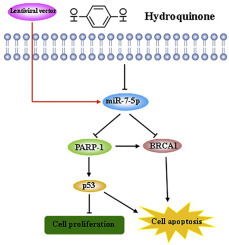Chemico-Biological Interactions ( IF 5.1 ) Pub Date : 2018-02-05 , DOI: 10.1016/j.cbi.2018.01.019 Hao Luo 1 , Hairong Liang 1 , Yuting Chen 1 , Shaoyun Chen 1 , Yongchun Xu 1 , Longmei Xu 1 , Jiaxian Liu 1 , Kairu Zhou 1 , Jucheng Peng 2 , Guoqiang Guo 2 , Bei Lai 1 , Li Song 1 , Hui Yang 1 , Linhua Liu 1 , Jianming Peng 3 , Zhidong Liu 3 , Lin Tang 4 , Wen Chen 5 , Huanwen Tang 1

|
Hydroquinone (HQ), one of the major metabolic products of benzene, is a carcinogen, which induces apoptosis and inhibit proliferation in lymphoma cells. microRNA-7-5p (miR-7-5p), a tumor suppressor, participates in various biological processes including cell proliferation and apoptosis regulation by repressing expression of specific oncogenic target genes. To explore whether miR-7-5p is involved in HQ-induced cell proliferation and apoptosis, we assessed the effect of miR-7-5p overexpression on induction of apoptosis analyzed by FACSCalibur flow cytometer in transfection of TK6 cells with miR-7-5p mimic (TK6- miR-7-5p). We observed an increased apoptosis by 25.43% and decreased proliferation by 28.30% in TK6-miR-7-5p cells compared to those negative control cells (TK6-shNC) in response to HQ treatment. Furthermore, HQ might active the apoptotic pathway via partly downregulation the expression of BRCA1 and PARP-1, followed by p53 activation, in TK6-miR-7-5p cells. In contrast, attenuated p53 and BRCA1 expression was observed in shPARP-1 cells than in NC cells after HQ treatment. Therefore, we conclude that HQ may activate apoptotic signals via inhibiting the tumor suppressive effects of miR-7-5p, which may be mediated partly by upregulating the expression of PARP-1 and BRCA1 in control cells. The increase of miR-7-5p expression further intensified downregulation of PARP-1 and BRCA1 in TK6-miR-7-5p cells, resulting in an increase of apoptosis and proliferation inhibited.
中文翻译:

miR-7-5p过表达通过抑制对苯二酚暴露的TK6细胞中PARP-1和BRCA1的DNA损伤修复能力抑制细胞增殖并促进细胞凋亡
对苯二酚 (HQ) 是苯的主要代谢产物之一,是一种致癌物质,可诱导淋巴瘤细胞凋亡并抑制其增殖。microRNA-7-5p (miR-7-5p) 是一种肿瘤抑制因子,通过抑制特定致癌靶基因的表达参与细胞增殖和凋亡调节等多种生物学过程。为了探索 miR-7-5p 是否参与 HQ 诱导的细胞增殖和凋亡,我们评估了 miR-7-5p 过表达对诱导细胞凋亡的影响,通过 FACSCalibur 流式细胞仪分析用 miR-7-5p 转染 TK6 细胞模拟 (TK6-miR-7-5p)。我们观察到与那些响应于 HQ 处理的阴性对照细胞 (TK6-shNC) 相比,TK6-miR-7-5p 细胞的细胞凋亡增加了 25.43%,增殖减少了 28.30%。此外,在 TK6-miR-7-5p 细胞中,HQ 可能通过部分下调 BRCA1 和 PARP-1 的表达,然后激活 p53 来激活细胞凋亡途径。相反,在 HQ 处理后,在 shPARP-1 细胞中观察到的 p53 和 BRCA1 表达比在 NC 细胞中减弱。因此,我们得出结论,HQ 可能通过抑制 miR-7-5p 的肿瘤抑制作用激活细胞凋亡信号,这可能部分是通过上调对照细胞中 PARP-1 和 BRCA1 的表达来介导的。miR-7-5p 表达的增加进一步加剧了 TK6-miR-7-5p 细胞中 PARP-1 和 BRCA1 的下调,导致细胞凋亡增加和增殖受抑制。在 HQ 处理后,在 shPARP-1 细胞中观察到 p53 和 BRCA1 表达比在 NC 细胞中减弱。因此,我们得出结论,HQ 可能通过抑制 miR-7-5p 的肿瘤抑制作用激活细胞凋亡信号,这可能部分是通过上调对照细胞中 PARP-1 和 BRCA1 的表达来介导的。miR-7-5p 表达的增加进一步加剧了 TK6-miR-7-5p 细胞中 PARP-1 和 BRCA1 的下调,导致细胞凋亡增加和增殖受抑制。在 HQ 处理后,在 shPARP-1 细胞中观察到 p53 和 BRCA1 表达比在 NC 细胞中减弱。因此,我们得出结论,HQ 可能通过抑制 miR-7-5p 的肿瘤抑制作用激活细胞凋亡信号,这可能部分是通过上调对照细胞中 PARP-1 和 BRCA1 的表达来介导的。miR-7-5p 表达的增加进一步加剧了 TK6-miR-7-5p 细胞中 PARP-1 和 BRCA1 的下调,导致细胞凋亡增加和增殖受抑制。



























 京公网安备 11010802027423号
京公网安备 11010802027423号